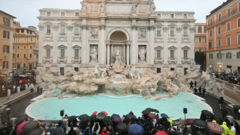Rome's cherished Trevi Fountain has reopened its doors to the public after an extensive three-month restoration. This iconic baroque masterpiece, designed in the 18th century by renowned architect Nicola Salvi and situated on the façade of the historic Poli Palace, previously attracted between 10,000 and 12,000 visitors daily. In response to the overwhelming crowds, city officials have introduced a new queuing system to ensure a more pleasant experience for all who come to admire the landmark.
Rome's Mayor, Roberto Gualtieri, highlighted that the limit on visitor numbers will help eliminate congestion, allowing tourists to fully enjoy the beauty of the fountain without the chaos of large crowds. In addition to the new system, the city is contemplating the introduction of a modest entry fee to support the ongoing maintenance and preservation of this historic site.
The reopening was celebrated on Sunday, even under drizzling rain, attended by hundreds of tourists who joyfully followed the tradition of tossing coins into the fountain, a custom believed to bring good fortune. The three-month cleaning project aimed to remove unsightly mould and calcium buildup, ensuring that the Trevi Fountain remains a dazzling highlight leading up to the jubilee of the Roman Catholic Church, set to commence on Christmas Eve.
The restoration efforts had become increasingly necessary, particularly after structural issues surfaced in 2012, when portions of the fountain's detailed cornice began to crumble following a severe winter. This prompted an extensive multi-million euro renovation. The tradition of coin tossing, notably popularized by Frank Sinatra's "Three Coins in the Fountain," has historically generated around €10,000 weekly, with funds directed towards a charity that provides meals for those in need.
Commissioned by Pope Clement XII in 1730, the Trevi Fountain is not only a mesmerizing architectural wonder; it also marks the terminus of the ancient aqueduct that once supplied Rome with water. The Acqua Vergine aqueduct extends for an impressive 20 kilometers (12 miles) and culminates in the fountain, where visitors can also quench their thirst at a special tap located discreetly on the side. According to legend, the water source was discovered by Roman soldiers in 19 BC, guided there by a young virgin — a tale that gives the fountain its enduring name, Virgin Waters.




















